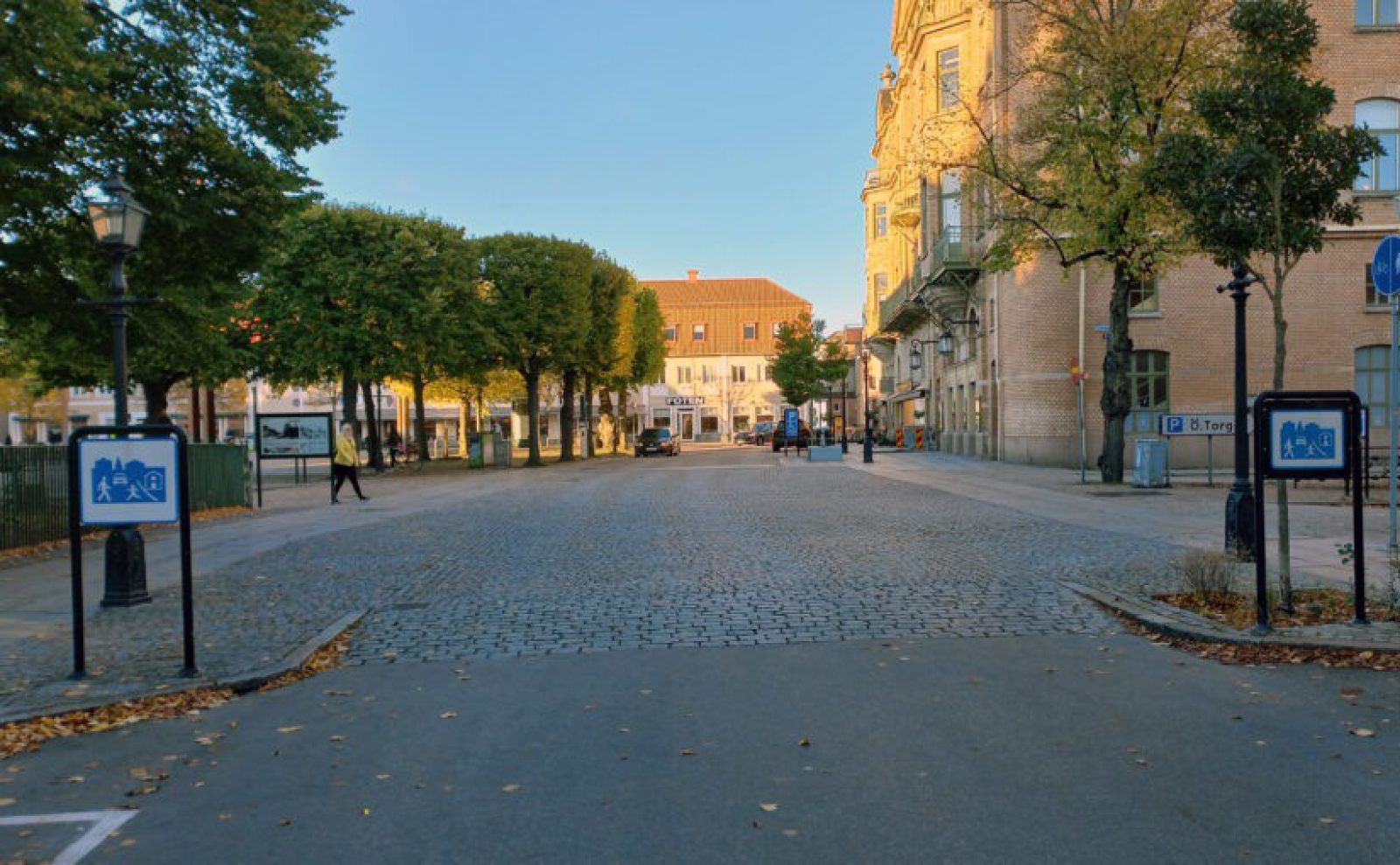
The new normal: 30 km/h Low Speed Zones
The new normal: 30 km/h Low Speed Zones
Introduction
Resolution 11 of the Stockholm road safety declaration 2020 reads: ‘Focus on speed management, including the strengthening of law enforcement to prevent speeding and mandate a maximum road travel speed of 30 km/h (or 20 mph) in areas where vulnerable road users and vehicles mix in a frequent and planned manner’. It continues: ‘except where strong evidence exists that higher speeds are safe, noting that efforts to reduce speed in general will have a beneficial impact on air quality and climate change, as well as being vital to reduce road traffic deaths and injuries’.
Author: Philip Wijers.
This resolution, when carried out, will have major implications on how we design and use the urban environment, on our transport choices, on social interaction and on the demand for a wide range of products and services (e.g. 15 minute cities). It will certainly lead to more and larger Low Speed Zones (LSZ) or Zones 30 (or 20 for miles-countries) that have already been credited with improved road safety, fewer cars, less traffic noise, lower emissions, more pedestrian and cycling traffic and better connectivity between neighbourhoods. In short, improved quality of life for citizens in urban environments. In light of this the 6th UN Global Road Safety Week 2021 was titled Streets for Life, #Love30.
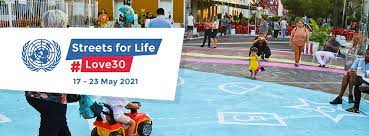
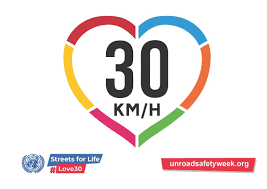
Images: UN Global Road Safety Week – https://www.unroadsafetyweek.org/en/home
The urban jungle for VRUs
Targeting urban areas to improve road safety makes sense. As of 2007 the majority of the world’s population lives in urban areas. In 2020 this increased to 56,2% and the UN expects this to rise to 68% in 2050.
Speed is a killer, especially for vulnerable road users (VRU), who, unlike those in cars, are not protected by an impact resistant harness. Although more traffic deaths (53%) occur on secondary, non-urban roads, compared to urban (38%), it is the VRUs, with a share of 69%, that stand out in EU urban casualty statistics. This group will benefit most from speed reduction in general and the introduction of LSZs in particular.
Historically, the road safety benefits of automated enforcement and improved and NCAP required in-vehicle technologies (airbags, seat belts, ABS, etc) have benefited occupants of 4+ wheeled vehicles much more than VRUs. Additionally, the scooter and motorcycle mobility explosion in many LMICs has also contributed to the increased representation of VRUs in injury and casualty statistics. Thus the share of pedestrian, cycling, and motorcycling fatalities compared to the share of other road users continues to increase.
The COVID pandemic has seen a strong increase in two-wheeler use, for bicycles often on non-suitable infrastructure. This increase is bound to further worsen VRU vulnerability and their road safety statistics. San Francisco already noticed this and plans to take infrastructure adaptation and speed camera enforcement measures.
In the Netherlands, which has a very high share of intra-urban bicycle mobility, bicycle fatalities have roughly equalled car fatalities since 2011 Between 2009 and 2013 in seven EU countries investigated, 26,670 VRUs were killed and 10 times more (265,400) were seriously injured. According to the European Transport Safety Council (ESTC) the death risk per 100 million person kilometres travelled is 13.8 for motorised two-wheelers, 6.4 for pedestrians, and 5.4 for bicyclists in Europe. This is to be compared with a death risk of 0.7 for car users and 0.07 for bus passengers. Therefore, a focus on urban areas, safer speeds and VRUs, as also specified in the 2nd UN Decade of Action for Road Safety, is very likely to reap sizable road safety benefits. As mentioned this focus is realised in the Low Speed Zone urban concept that has rapidly been gaining ground, often in high income countries, but also in Latin America. LSZs have been around since the 1990s in Europe on a limited street or neighborhood level. Recently the trend has moved in scale to entire cities or nations (Spain) implementing LSZs. The next paragraphs of this paper provide further insight into the benefits and challenges of LSZs.
What is a Low Speed Zone?
A simple answer is easily given, but it is obviously far more complex to implement than putting up a few 30km/h speed signs and enforcing it with speed cameras. The central concept behind LSZs is that they should be self-enforcing i.e. the infrastructure should be designed in such a way that speeds above 30 km/h are discouraged or under normal circumstances impossible. Converting streets, neighbourhoods or cities to LSZs mostly means changes to the layout, infrastructure and street furniture.
Low speed zones are not new. Residential streets and neighbourhoods have been adapted or even designed and planned from the start as low speed areas. The ‘woonerf’, ‘residential zone’ or ‘living street’ idea originated in the Netherlands in the 1970s and was implemented in various ways in many countries. The speed limit is 15 or 20 km/h and cars are seen as visitors that always have to yield to pedestrians and cyclists. Streets in residential zones in the Netherlands are also meant to be safe enough for playing children due to the often chicane shaped infrastructure layout.
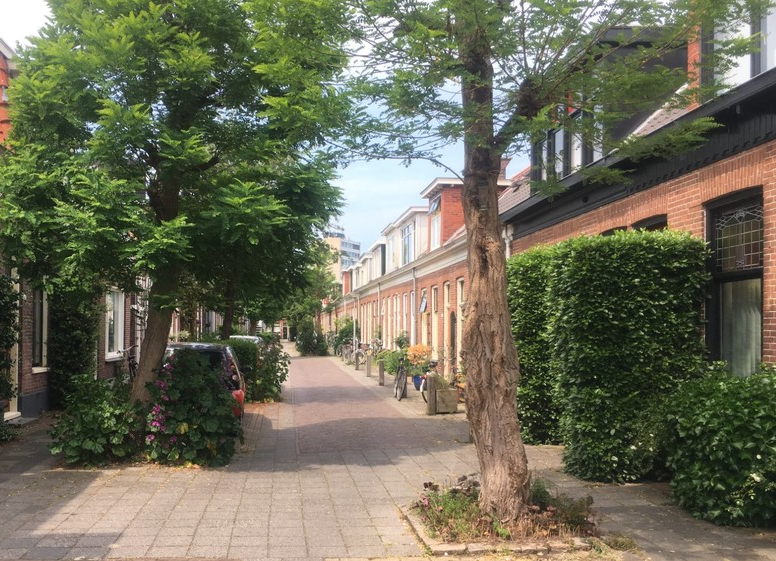
Chicane shaped infrastructure in Dutch ‘woonerf’ or residential zone.

Woonerf or residential zone traffic sign
The broader ‘Shared Space’ idea first implemented in the 1990s in the Netherlands is closely related. Japan applied shared space much earlier in most residential areas. However, not as a design or road safety concept but due to narrow streets which cannot accommodate vehicle parking or infrastructure separation of road users.
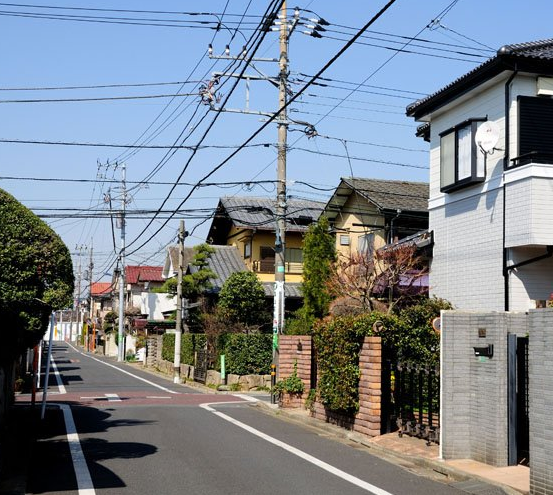
Shared space is the default infrastructure design in most Japanese residential neighborhoods.
Shared space is also applied to urban squares and other non-residential areas. Conceptually, it minimises segregation between the various types of road users. This is accomplished by removing some or all traffic regulating aspects such as traffic signs, kerbs, road markings and traffic lights. Key aspects of shared space are uncertainty about the right of way and yielding based on mutual understanding and communication, mostly through eye contact. This requires proximity. The uncertainty over who has the right of way and the required short range communication and understanding about this results in lower speeds. The shared space approach was also introduced in many countries and comes in many variations and adaptations, also answering to criticism by organisations representing the elderly, handicapped, blind and deaf people. It is more a design approach based on an idea (safety due to uncertainty) than a fixed concept with solid rules, standards and design criteria.
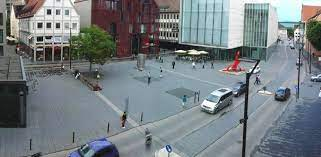
Shared space in Ulm, Germany (Image: https://ec.europa.eu/transport/sites/default/files/cycling-guidance/difu_cycling_expertise_shared_space.pdf)
Vision Zero (Sweden) and Sustainable Safety (Netherlands) also starting in the 1990s took human errors as unavoidable and came with a holistic transport system approach, with speed management also strongly infrastructure driven.
Why 30 km/h as speed limit?
The formula for kinetic energy reads KE=1/2 mv2. Due to the squared speed (v2) the impact of a crash (KE) increases exponentially with higher speeds and so does the risk of a deadly crash (graph). The human body is notoriously sensitive and unsuited to withstand physical impacts. A speed reduction from 50 to 30 km/h thus results in a 70% lower fatality risk for pedestrians. This is also due to an almost exponential reduction in braking distances at lower speeds, similarly related to the above mentioned formula. The VRU fatality risk of an impact with 50 km/h is 4-5 times higher than with 30 km/h. Also in line with that formula and including reaction time, the stopping distance when braking at more than doubles when the speed increases to 50 km/h.With 15 or 20 km/h residential zones may have even lower speed limits to also accommodate children playing on the streets.

Image: Singapore Highway Code
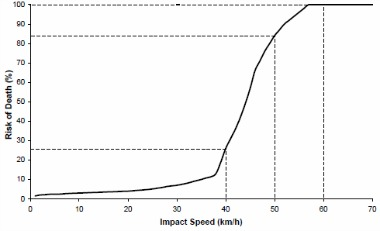
Probability of fatal injury in relation to vehicle speed (‘Improving Pedestrian Safety,’ Curtin-Monash Accident Research Centre)
Implementing Low Speed Zones
LSZ implementation consists of four phases: planning, design, construction and post-construction. An important key to success is political support and early involvement of all relevant parties. But notwithstanding this and clear benefits, LSZs may not be easy to implement in practise. Despite their positive evaluation in many studies some stakeholders may have strong reservations about LSZs. Often heard arguments include: bad for business, higher emissions and more noise due to stop and go traffic, congestion and traffic diversion to neighbouring streets.
In the planning phase the scope and scale are obviously a key consideration. Politics play a crucial role here. LSZs can be implemented at single street level but can also become the residential design standard on a national level. Increasingly, mayors and city councils take a leading role in turning large parts of their cities into LSZs often as part of an overall strategy to increase the livability of their cities and quality of life for their residents. No matter what the scale and scope, planning and implementation are greatly facilitated by national LSZ design guidelines, but again the creation of national guidelines is also politically driven. This only works if the national political culture is cooperative and able to pursue the strategic long term interest in the well-being and safety of the country and its citizens.This similarly applies to the implementation of an LSZ at street level. Here trust and a cooperative spirit between all stakeholders is crucial for progress.
Apart from politics, the legacy problem of car-centric urban planning also stands in the way. This has led to a range of persistent issues: urban sprawl, barrier effects created by wide distributor roads, pollution, congestion, a parking dominated urban landscape and underdeveloped public transport facilities that would encourage local walking and cycling. This is often an impediment on the city wide implementation of LSZs.
The excellent and practical Low Speed Zone Guide, published by the World Resources Institute (WRI) and the World Bank’s Global Road Safety Facility (GRSF), provides valuable advice on the various LSZ implementation phases and provides relevant case studies. Downloadable from the link below.
Notable LEZ Examples
The fervour of Anne Hidalgo, mayor of Paris, for her ‘Paris Respire’ (Paris Breathes) programme which also includes a massive LSZ since August 2021 has seen a lot of publicity and may set an example for other key global cities. Paris was not the first city in France to implement an LSZ, Grenoble, Lille Montpellier, Nantes and many other cities preceded Paris. A study by the French national research institute Cerema (Centre for Studies on Risks, the Environment, Mobility and Urban Planning) found that the number of pedestrians injured or killed in Grenoble had been halved since the Alpine city introduced the LSZ in January 2016.
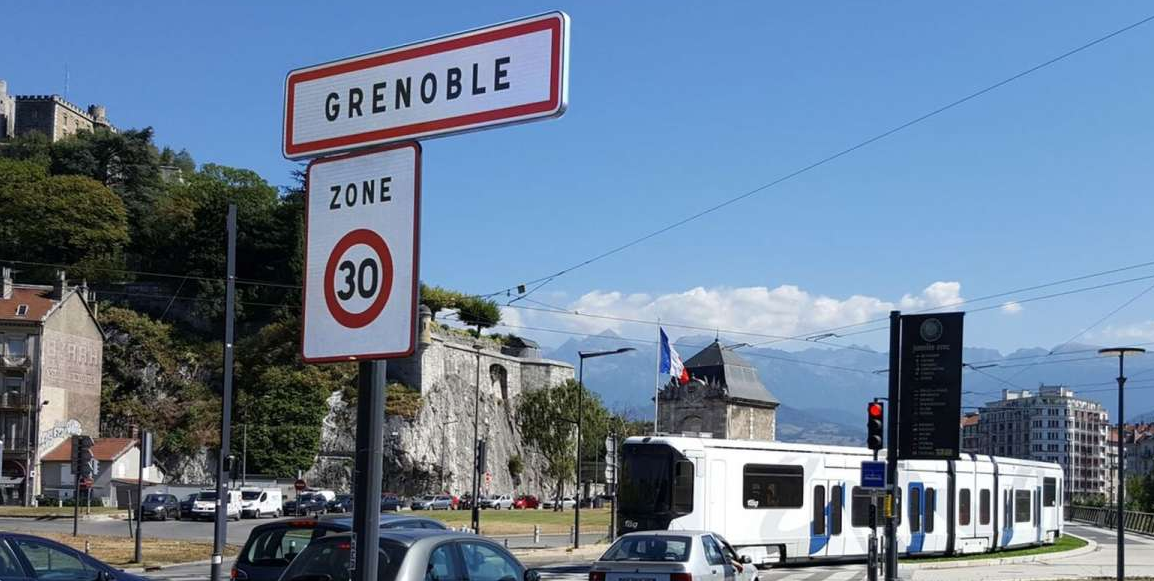
Image: Cerema (https://www.cerema.fr/fr/actualites/apaiser-circulations-echelle-metropolitaine-cerema-evalue)
Brussels started with a 30 km/zone on January 1st, 2021. This led to a quick drop in traffic casualties, injuries and crashes, although the Covid pandemic may act as an intervening variable. In general 50 km/h roads were reduced to 30 km/h and 70 km/h to 50 km/h. Enforcement was also tightened by installing 60 new speed cameras. Depending on the road the average speeds dropped between 7% and 19%. On aggregate such speed reductions lower the total amount of energy in the Brussels road network which is bound to translate into positive road safety benefits.
In Spain the national government took the lead with LSZ implementation by introducing a new traffic law that applies to all cities. This law states the following with respect to speed limits on urban roads from 11 May 2021,
- 20 km/h on roads that have a single carriageway and sidewalk platform.
- 30 km/h on single lane roads in each direction of travel.
- 50 km/h on roads with two or more lanes in each direction of traffic.
At the same time the national government issued an implementation handbook that may be practical for other Spanish speaking countries available via the link below.
Since the implementation of an LSZ is much more than only speed law, the actual realisation of LSZs in Spanish cities with suitable infrastructure to slow traffic down will take longer. Bilbao is taking the lead here, also with a resulting 23% decrease in crashes. Spanish urban distributor roads with a 50 km/h speed limit where infrastructure measures are more difficult to implement may need cameras to force speed compliance.
In Latin America, Bogota is a clear trend setter with an early LSZ start and an active Vision Zero programme. The LSZ in the Columbian capital is also featured as case study in the WRI/GRSF LSZ Guide referred to above.
In Africa in Dar Es Salaam, Tanzania started with LSZs in connection with school zones. The project was funded by the FIA Foundation and executed by Amend, Centers for Disease Control and Prevention (CDC), local authorities and school administrators. The Dar Es Salaam LSZs also feature as case study in the WRI/GRSF LSZ Guide.
In the United States the twin cities of Minneapolis and St. Paul were early adopters of lower speeds with a default 20 mph (unless otherwise posted), also in conjunction with a Vision Zero road safety programme. Seattle lowered its speed limit from 25 to 20 mph on neighborhood streets and from 30 to 25 mph on connector roads in 2016. Portland, Oregon, also a Vision Zero city followed in 2018 and lowered the default speed limit in residential areas from 25 mph to 20 mph.
For many LSZ cities and neighbourhoods street redesign and implementation of self-enforcing infrastructure to keep speeds low remains limited, which means that increased enforcement, either manual or automated, and publicity is required to increase compliance.
Summary
Low Speed Zones (LSZs) which started on street level, are bound to proliferate in cities across the world, also in scope and scale, with Paris and Brussels as clear examples. An LSZ works best when effective infrastructure adjustments are made to keep speeds down.This self-enforcing concept does not work on distributor roads which most major cities still need to function properly. Here automated enforcement combined with publicity is required to force compliance.
The benefits of an LSZ are clear: improved road safety, especially for vulnerable road users, fewer cars, less traffic noise, lower emissions, more pedestrian and cycling traffic and better connectivity between neighbourhoods. This improves the livability and quality of life for its citizens, but also for tourists and other visitors. Some stakeholders may still need to be convinced, but most studies report favourable results and careful planning and early involvement as described in the practical WRI / GRSF Low Speed Zone Guide16 will help the LSZ concept spread further and wider.
- https://www.roadsafetysweden.com/about-the-conference/stockholm-declaration/
- https://www.15minutecity.com/
- https://www.unroadsafetyweek.org/en/home
- https://ec.europa.eu/transport/road_safety/sites/roadsafety/files/pdf/scoreboard_2020.pdf
- https://www.msn.com/en-us/news/us/covid-19-pandemic-leads-to-higher-rate-of-traffic-deaths-in-san-francisco/ar-AAOewc0
- https://www.cbs.nl/en-gb/news/2020/31/decline-in-road-fatalities-larger-among-motorists-than-cyclists
- https://www.sciencedirect.com/science/article/abs/pii/S0022437518304171
- ETSC (2003) Transport safety performance in the EU. A statistical overview. Brussels: European Traffic Safety Council, http://www.etsc.eu/oldsite/statoverv.pdf
- https://www.who.int/teams/social-determinants-of-health/safety-and-mobility/decade-of-action-for-road-safety-2021-2030
- https://en.wikipedia.org/wiki/Woonerf https://en.wikipedia.org/wiki/Living_street
- https://en.wikipedia.org/wiki/Shared_space
- https://www.victoriawalks.org.au/safe_speed/
- https://www.nrspp.org.au/resources/fact-sheet-6-improving-pedestrian-safety/
- https://www.itf-oecd.org/sites/default/files/docs/speed-crash-risk.pdf
- https://sso.agc.gov.sg/SL/RTA1...
- https://files.wri.org/d8/s3fs-public/2021-05/WRI_LowSpeedZone_web.pdf?VersionId=mMwA8aq.BSpHZ6w97Z4E2NSd5o1UPN7B
- https://www.rfi.fr/en/france/20210830-paris-caps-speed-limit-to-30km-h-in-further-boost-to-soft-transport-road-safety-hidalgo
- https://ville30.org/
- https://www.cerema.fr/fr/actualites/apaiser-circulations-echelle-metropolitaine-cerema-evaluent,
- https://www.bruzz.be/mobiliteit/60-bijkomende-flitspalen-voor-algemene-zone-30-2020-06-17
- https://www.brusselstimes.com/brussels-2/169502/brussels-30-km-h-zones-5-months-on-less-accidents-city-30/
- https://revista.dgt.es/es/noticias/nacional/2021/04ABRIL/0413-Guia-Ciudades-30.html
- https://eurocities.eu/latest/bilbao-slow-and-steady-for-the-win/
- https://thecityfix.com/blog/bogotas-vision-zero-road-safety-plan-saving-lives-dario-hidalgo-claudia-adriazola-steil/
- https://files.wri.org/d8/s3fs-public/2021-05/WRI_LowSpeedZone_web.pdf?VersionId=mMwA8aq.BSpHZ6w97Z4E2NSd5o1UPN7B
- https://www.minnpost.com/metro/2020/11/the-speed-limit-is-now-officially-20-mph-in-minneapolis-and-st-paul-what-that-means-and-how-it-could-affect-street-life-in-the-cities/
